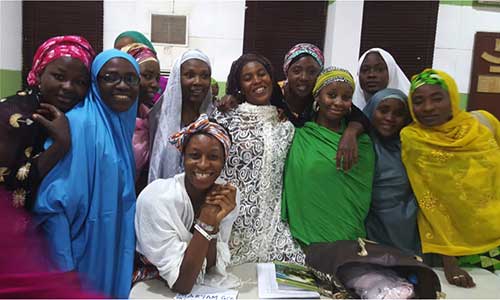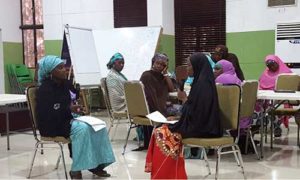“Education is the most powerful weapon which you can use to change the world.”
– Nelson Mandela
ABUJA, Nigeria – “Are you sure you know where you are coming to?” asked my cousin in-law as we approached the northwestern state of Kaduna after a two hour road trip from Abuja. He was dropping me off at a bus stop on his way to Kano for a work trip. I was going to Zaria, a city about one hour away from Kaduna. Before I got out of the car, he briefed me on the history of religious conflict in Kaduna and urged me to be careful. A few years back, Christians were killed along the Kaduna expressway for their belief. As people drove by, they were stopped and asked what religion they belonged to: Christian or Muslim. Anyone who identified as a Christian was killed. As he narrated this story, I was reminded of the unconventional nature of the work I had come to do in Nigeria, and for a moment, I felt fear creep into my mind. He asked me “what would you do if something happens?” I quickly assured him that I would be meeting up with a reputable contact and staying in a safe environment- on the campus of the renowned Ahmadu Bello University, and that I knew my safety precautions. Thus began my first encounter of Northern Nigeria.
Soon after my in-law dropped me off, I got into a tricycle taxi, called my contact in Zaria who negotiated my fare using the Hausa language and made sure the driver knew where to take me to. In about 20 minutes, I arrived at the University campus and joined the workshop that was already in progress. I had come to Zaria to observe a Monitoring & Evaluation training workshop for the Adolescent Girls Initiative (AGI) project sponsored by the United Nations Population Fund (UNFPA). (The project is being implemented by the Centre for Girls’ Education (CGE), a joint program of the Population & Reproductive Health Initiative (PRHI) at Ahmadu Bello University and the School of Public Health at the University of California, Berkeley.)[1]
The AGI project seeks to keep about 10,000 girls in school and delay child marriage in the northern Nigerian states of Kaduna and Kebbi through the use of “safe space” girls groups. Safe Spaces are classroom-like settings within local communities where adolescent girls meet, discuss, and learn basic academic competencies including literacy and numeracy, along with leadership and life skills. Trained female community volunteers lead the Safe Spaces, which provide girls with a warm and unassuming environment.
Prior to this trip to Zaria, what I knew of northern Nigeria came from media reports and stories from people who had visited some areas in the North. Typical images that are portrayed of the North include illiterate and uncivilized people, Muslims, and severe poverty. Despite these initial presumptions, I kept an open mind to discover, firsthand, the people and culture in Zaria. As I entered the workshop, I observed a group of about 30 women dressed in beautiful and brightly colored native attire with their hair covered with scarfs. Upon my inquiry, I was told that native attire is the commonly practiced and accepted mode of dressing in the (northern) communities where these women come from, even in a training/professional setting like the workshop. Dressing in the attire of the community demonstrates seriousness about work and allows for acceptance by members of the community. Unfortunately, I felt completely out of place in my button-up blue and black striped shirt and black trousers and couldn’t wait to change into more informal garb that, fortunately, I had packed.
The female participants, ranging from their early twenties to about forty years old sat attentively. They were recruited from Kaduna and Kebbi states to work as “Mentor-Supervisors” on the AGI project. Many are recent graduates from University and some were engaged in business activities or unemployed. The project provides them with a source of income for the year.
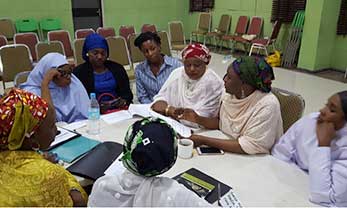
Mentor Supervisors engaged in a role-play
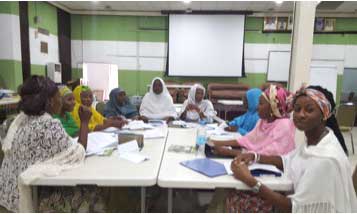
Understanding the Local Context
The United Nations Educational, Scientific and Cultural Organization (UNESCO) has established that “[e]ducation is a fundamental human right and essential for the exercise of all other human rights. It promotes individual freedom and empowerment and yields important development benefits.”[2] The question that gnaws at me is this: why do girls continue to remain out of school? Globally, and as US First Lady Michelle Obama reminds us, there are over 62 million school-aged girls who are not in school.[3] In countries like Nigeria, the prevailing reasons for this include culture/lack of value for the girl child, poverty, and social norms. Over the course of my Fellowship, I want to find out how exactly do these factors hinder girls from attending school — and what needs to be done to ensure girls can attend and stay in school.
In Zaria, I learned, first, that it is important to distinguish our assumptions from the realities/facts of the matter of girls’ education; and second, that education (particularly literacy, numeracy and health & life skills) empowers girls to be agents of change.
On the realities of girls’ education
Based on research carried out by CGE staff, two factors keep girls out of school: government policies and the quality of education. Free and compulsory Universal Basic Education (UBE) Programme is on the books, but not implemented, across Nigeria.[4],[5] As one Nigerian writer puts it “While UBEC might have played a role in universal access to education at the foundation level, it is uncertain that the commission has laid much emphasis on the quality of education offered Nigerian pupils.”[6] Even when tuition is free, there are hidden fees such as textbook fees, Parent, Teacher, Association (PTA) fees, project fees, interhouse sports fees, and exam/test fees. When a student is unable to pay these fees, she/he is sent away from school.
So, it appears that parents are willing to send their daughter(s) to school if the fees are reduced and if it can be guaranteed that the girl would be able to read and write upon graduation. For example, parents would like for their daughter to be able to help them conduct a bank transaction because she has literacy and numeracy skills that she gained from school. But many parents, according to the findings from the CGE research, are dissatisfied with the poor educational outcomes of students in their community; their daughters never learn to read and write even after completing nine years of basic education! This startling reality begs the question: how is this possible? It highlights the discrepancies in educational standards and outcomes across Nigeria. One answer for why a girl with nine years of “education” is not able to read and write [in English] is that many schools in rural and Northern Nigeria teach in the local language. For example, in Northern Nigeria, most parents send their children (especially girls) to Qur’anic schools rather than formal schools.[7] Also, a girl’s learning is not always prioritized in the classroom. “Boys are generally known to be given more opportunities to ask and answer questions, to use learning materials, and to lead groups.”[8] I have spent time with a young lady (18 years old) from the middle-belt region of Nigeria who cannot read, write or speak English at a basic/primary level. She tells me she graduated from secondary school in her village a couple of years ago. She presently works as a domestic helper and is saving money to further her education. This young lady, from what I have observed, will need literacy and numeracy classes before she can pursue further education.
Because most families in northern Nigeria are very poor, every member of the family is expected to contribute to the family economy and survival. Hence, the costs of sending a child to school becomes a critical decision factor. Because girls are culturally and socially valued for their domestic contributions in the home, boys are chosen to attend school.[9] In light of this, advocates for girl-child education must be able to provide evidence which will prove not just the social and human rights value of education, but most importantly, the economic value for the girl’s family and her community.
On the lesson of education as a force for girl empowerment
While in Zaria, I also observed a training of adolescent girls as “cascading mentors” for the AGI project. As graduates and as CGE success stories, they are being trained to mentor the next group of adolescent participants. The girls ranged from age 17 to 22 years old and come from rural communities in Kaduna state. Some of them are married and have a child. (This is something I am curious to explore further in the future: why these girls get married right after secondary school).
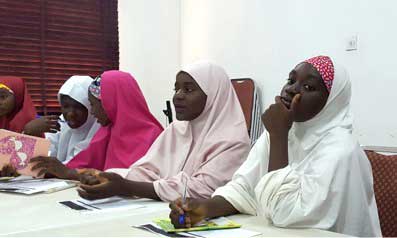
Prior to their involvement in the CGE program, many of them could not express themselves in English and they lacked confidence. As they stood up and spoke boldly when asked a question during the training, it was clear that a remarkable change had taken place as a result of the CGE program. While the girls read out sentences from the PowerPoint presentation in English, they were more comfortable sharing about the impact of the program in their lives in their native Hausa language. I was impressed as the girls accurately explained terms such as “consequences,” “vesicovaginal fistulae (VVF),” “mortality,” and “morbidity.”
In sharing about the impact of the CGE program in their lives, below are some translated-to-English anecdotes from their testimonials:
“I was in primary 4; from a family of five girls and one boy. My father was expecting me to get married after Primary 5 [9/10 years]. I did not even know what hygiene is. I had no aim/purpose during the day. In the CGE program, I learned a lot about life skills. I proceeded to JSS 3, which is the height [stopping point] of education for many girls in my community. I am now a graduate of secondary school and I want to become a teacher and mentor other girls so that I can pass on the information. I am not married.”
“Before the CGE program, I had a very low self-esteem and poor communication skills. I used to be very aggressive. Because of CGE, I have been able to impact my younger siblings and I have become a role model to them.”
“I come from a very poor home. I had never dreamed of entering a university environment and sitting with people in a meeting. There are other secondary school graduates in my community, but there is a clear difference between them and CGE girls. Before CGE, most of the girls in my community hawk. But as a result of being a part of the CGE program, we are able to serve as mentors. We are supported financially by CGE [through transport costs and stipends]. Therefore, we do not need to hawk as much. We have time to go to the safe spaces.”
“I was the worst student [academically] in primary school. In SS2, I became the Prefect of my school. I paid attention to the literacy and numeracy lessons in the safe space. My peers now want to be close to me. I give advice to my peers. Since SS2, I have gained more friends. I will use this opportunity [as a mentor] to impact more girls.”
With these clear examples of the change that is possible when girls are given a chance to learn and discover their potential, these statistics are all the more stark:
- Half (50.3%) of the female population in Nigeria is illiterate.[10]
- Forty-three percent of Nigerian girls are given out in marriage before their 18th Seventeen percent are married before their 15th birthday.[11]
- Child marriage rates vary widely across the geographic regions with numbers as high as 76% in the North West region and as low as 10% in the South East of Nigeria.11
- Many girls often are forced to marry against their will, indeed, they even have no idea that they will be getting married, until a day before the marriage. Parents make preparations with the suitor on behalf of the girl.
At the Monitoring & Evaluation training workshop, I asked one of the participants what she felt was a challenge for girls in her community. She responded “divorce” to my surprise, and went on to explain that there are several girls in her community who have been returned to their parents after few years of marriage. The husband sends the girl back to her parents’ home — often with their child — once he is no longer interested in having her as his wife. As a result, girls are plagued with social stigma and many of them are not able to make a life for themselves because they have been deprived of completing their education as a result of marrying early.
My short trip to Zaria (2.5 days) helped me realize the importance of understanding local contexts in order to address the challenges facing girls in their education and well-being. This understanding is most effectively gained through an ethnographic study of people in their natural environment. It is imperative to understand where the problems/challenges are before we can provide effective solutions. I plan to return to Zaria to delve deeper into the issues girls, parents, and community leaders/advocates face with promoting and supporting girl-child education in this part of Nigeria.
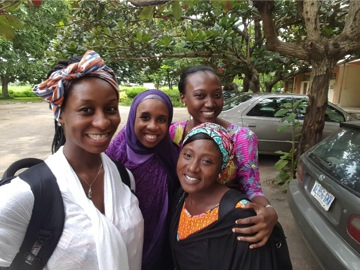
In other News…
- Nigeria is officially in a recession.[12] There are differing opinions on who/what is to be blamed for this situation. Unfortunately, it is the average Nigerian citizen (not the leaders/politicians) who is feeling the pinch of the dire economic conditions presently.
- Facebook Founder, Mark Zuckerberg visited Nigerian Tech Hubs in Lagos at the end of August and met with the Nigerian President! It was quite a big deal and signals Facebook’s interest in leveraging technology opportunities in Africa’s most populous country. [13]
________________________________________
[1] The CGE program originated in community-based research that showed, in 2007, that the median age of girls at marriage was 14.9, women’s literacy was 17%, and maternal mortality was 1,400 for every 100,000 women.[1] Since commencement of the program, substantial progress has been observed in all three of these metrics.
[2] United Nations Educational, Scientific and Cultural Organization. The Right to Education. http://www.unesco.org/new/en/right2education. Accessed: 10/10/2016
[3] http://edition.cnn.com/2015/09/27/living/michelle-obama-62-million-girls-feat/. Accessed: 09/22/2016
[4] http://ubeconline.com/about_ubec.php. Accessed: 10/03/2016
[5] https://www.naij.com/949570-free-education-hope-abandoned-rural-children.html. Accessed: 10/03/2016
[6] Ijeoma Nwogwugwu: Quality of education in Nigeria – Lessons from Malala Yousafzai. http://ynaija.com/ijeoma-nwogwugwu-quality-of-education-in-nigeria-lessons-from-malala-yousafzai/. Accessed: 10/10/2016
[7] UNICEF. http://www.unicef.org/nigeria/children_1937.html. Accessed: 10/10/2016
[8] UNICEF. Girls’ Education. http://www.unicef.org/wcaro/WCARO_Nigeria_Factsheets_GirlsEducation.pdf. Accessed 10/11/2016
[9] Girl Child Education in Nigeria: Why is it Important? http://nigerianfinder.com/girl-child-education-in-nigeria/. Accessed: 10/10/2016
[10] http://www.indexmundi.com/nigeria/literacy.html. Accessed: 10/11/2016
[11] http://www.girlsnotbrides.org/child-marriage/nigeria/. Accessed: 09/24/2016
[12] http://www.nigerianstat.gov.ng/report/434. Accessed: 09/20/2016
[13] http://qz.com/771838/facebooks-influential-nigerian-brain-trust-is-the-reason-zuckerberg-came-to-lagos-first/. Accessed: 09/20/2016

